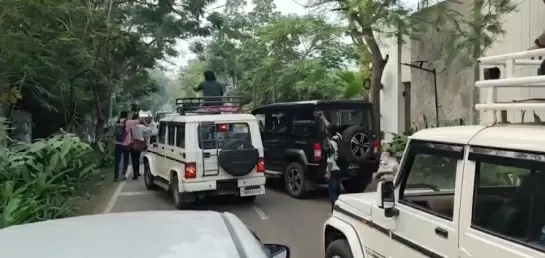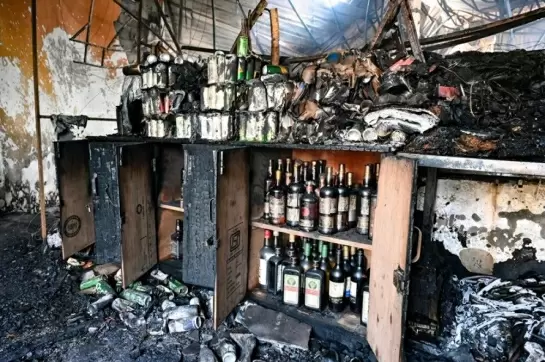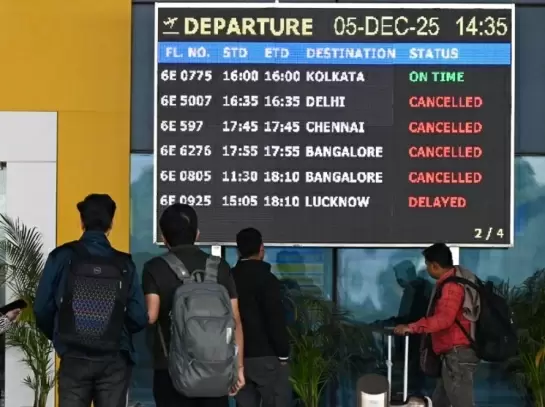The writing on the wall is clear when a Hindu paints Quranic verses: United we stand

10-November-2011
Vol 2 | Issue 45
December, 1991. Hyderabad, a city in the southern part of India, was in turmoil: a violent conflict had erupted between the city’s two dominant communities – Hindus and Muslims.
A curfew had been imposed, processions and rallies had been banned and shoot-at-sight orders were issued as the rampaging, armed groups clashed. Hundreds of houses had been on fire. Public life had come to a standstill.
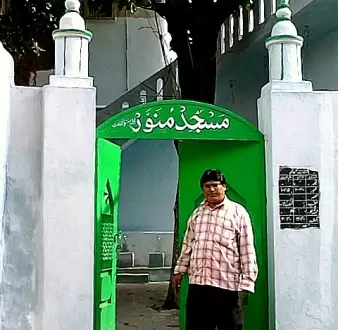 |
|
Anil Chauhan has been doing calligraphy at mosques in Hyderabad, painting the Quranic verses with passion
|
One of the worst affected neighborhoods in this riot was Moosa Bowli – a dingy area that hasn’t changed much since 1591 – the year Hyderabad was built by Qutb Shahi Sultans. The lanes are dark and incredibly narrow. Houses are small and resemble pigeon coops.
Amidst the deafening silence of curfew and occasional gun shots, Anil Chauhan –a 24-year old Hindu man and an aspiring calligrapher, sat inside one of the tiny houses with a twig pen.
With light yet swift strokes of the pen, he was writing the verse 36 of Sura Yaseen on a paper canvas, his heart completely lost in the art of creation. “Glory be to Him, Who has created all the pairs of that which the earth produces, as well as of their own (human) kind (male and female), and of that which they know not,” he wrote on, even as the lane outside his reverberated with cries of anger and hatred.
More than 2 weeks later, when the city regained its sanity, people of both the warring communities came together to take a collective look at the scar the riot had created.
What they saw was truly devastating: 150 dead and hundreds more were in hospital, seriously injured. And, as though this was not enough, more than a dozen mosques and temples lay completely razed. The question that everyone had was, ‘Is it going to happen again?’
The question was significant as Hyderabad - city of 8 million people, of which 40 percent are Muslims - had seen at least 4 communal riots in the past 4 decades.
As the community members pondered a solution, they realised that this cycle of violence and hatred, had to stop.
It was decided that citizens of Hyderabad needed to regain respect and faith in each other; they needed to be reminded of their shared history and cultural heritage.
And this is where Chauhan’s calligraphy fitted in perfectly: A Hindu artist, painting Quranic verses, amplifying the message of peace and humanity, as they are said in the Holy book.
Says Chauhan, who has done calligraphy on more than a 100 mosques in Hyderabad: “No religion preaches violence. It is the interpreter who gives out the wrong message. Islam is a religion of peace, yet many in my community have misgiving about it. So, it is really important to show people what the Quran really says. Calligraphy is a great tool to do that, so people can see and perceive the message themselves.”
But how did Chauhan develop such deep admiration for Islam and the Islamic art? And how did this Hindu man get to learn Islamic Calligraphy?
The story is as fascinating as Chauhan’s brush strokes.
“Growing up in old Hyderabad, where the majority of the population is Muslim, I used to walk on the streets and stare at the signboards outside shops. I would also stare at the writings on the walls of a mosque. They looked so exquisite to me! I wanted to learn to do that.”
But it wasn’t easy learning calligraphy, which is popularly perceived as an art for the Muslims alone. There was no formal school that taught the art either.
Chauhan’s relentless search for a teacher finally brought some result. ‘One day, I learnt of an old calligrapher whom everyone called “Khaja Painter”. I requested him to teach me the art and he agreed. I picked up the script with a lot of practice,” he recalls.
However, as Anil drew verses of Quran, he developed a deep interest in the holy book itself. “I wanted to read the verses and be able to perceive a calligraphic form to write them.”
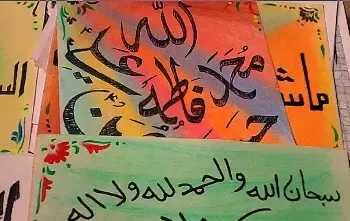 |
|
Chauhan’s story is as fascinating as his brush strokes
|
So, in next 4 years, Anil taught himself to read and write Urdu and kept honing his skills in artistic writing. The knowledge of the language had helped enhance his skills, he feels.
And indeed, the striking beauty of the jewel-like alphabets and designs inscribed on a sheet of paper grabs the immediate attention of the eyes. As Chauhan wielding two modest tools - a reed pen and ink- begins to write, alphabets transform into gems.
Soon, Chauhan’s calligraphy was also taken noticed of and approved by Jamia Nizamia – one of the oldest Islamic seminaries of the subcontinent.
“I wrote the ‘Sura Yaseen’, one of the chapters from the Quran for Jamia Nizamia Islamic University in the old city and my work was appreciated. The university authorities issued a ‘Fatwa’ saying that I could carry on these works. It was the proudest moment of my life,” he beams.
Syed Ahmed Ali –the secretary of Jamia Nizamia explains the fatwa. “When Jamia Nizamia was celebrating its 125 years, Anil Chauhan created a portrait that contained the entire Sura Yaseen.
“Everyone was impressed with that piece of work and we realized that Anil Chauhan, was not only good at calligraphy, but also had utmost respect for Islam and Islamic culture.”
In its 139-year old history, it was the only fatwa that Jamia Nizamia issued allowing a non Muslim to paint verses of Al Quran in mosques and other Islamic shrines.
Today, Anil has painted over a hundred mosques in and around Hyderabad. His service is free, and instead of money, he asks the mosque for a ‘few words on a paper’.
The gesture is significant as Chauhan’s financial background is extremely modest. In his office cum studio – a small, dusty room on the top of a mosque, there are bundles of such certificates of appreciation, which Chauhan shows off like precious trophies, with the pride of an Olympian.
However, academic and official recognition apart, Chauhan’s calligraphy is also aimed at strengthening inter-communal harmony. Has he been able to achieve this goal?
Chauhan’s reply is an emphatic ‘yes’. “We had a riot even in 2010, but this time, the damage was much less (2 death, 50 injured) and fizzled out rather quickly. The riot had started at a Hindu shrine. Soon after the riot, a new mosque was constructed barely 100 yards from that shrine and I was called to paint Quranic verses in the mosque.
“The mosque authorities also gave me a room right on top of the prayer hall which is now my permanent studio. This shows that a change is happening, isn’t it? I have a son who is in class 10. I think, he will never see a communal riot,” he wraps up, his eyes shining with hope.
Art, for this man, is never for the sake of art alone, but a divine tool to create a beautiful world of peace and brotherhood.












